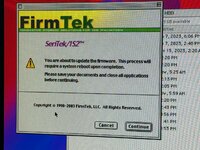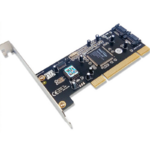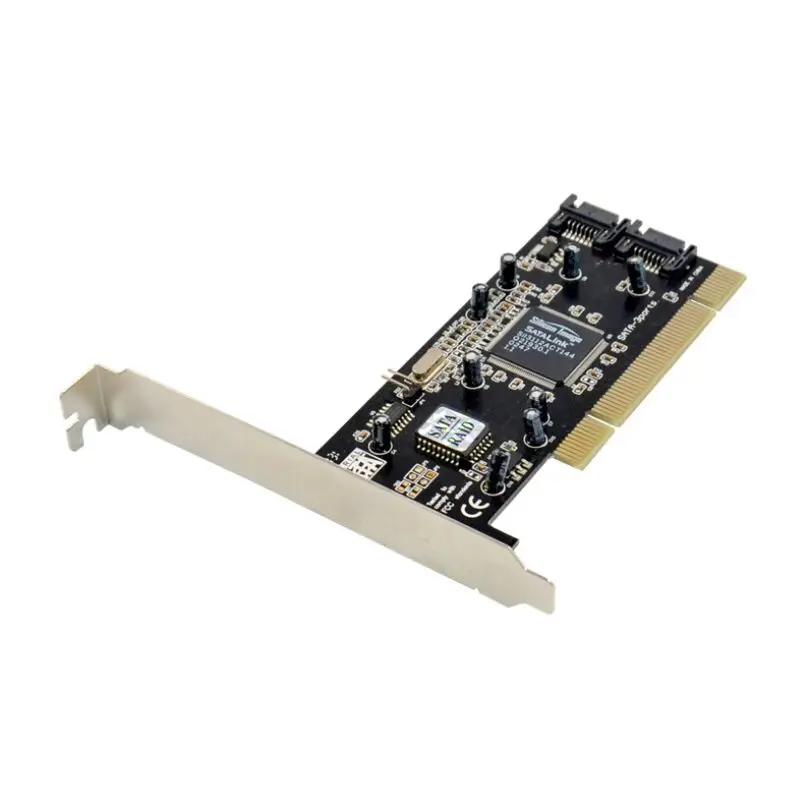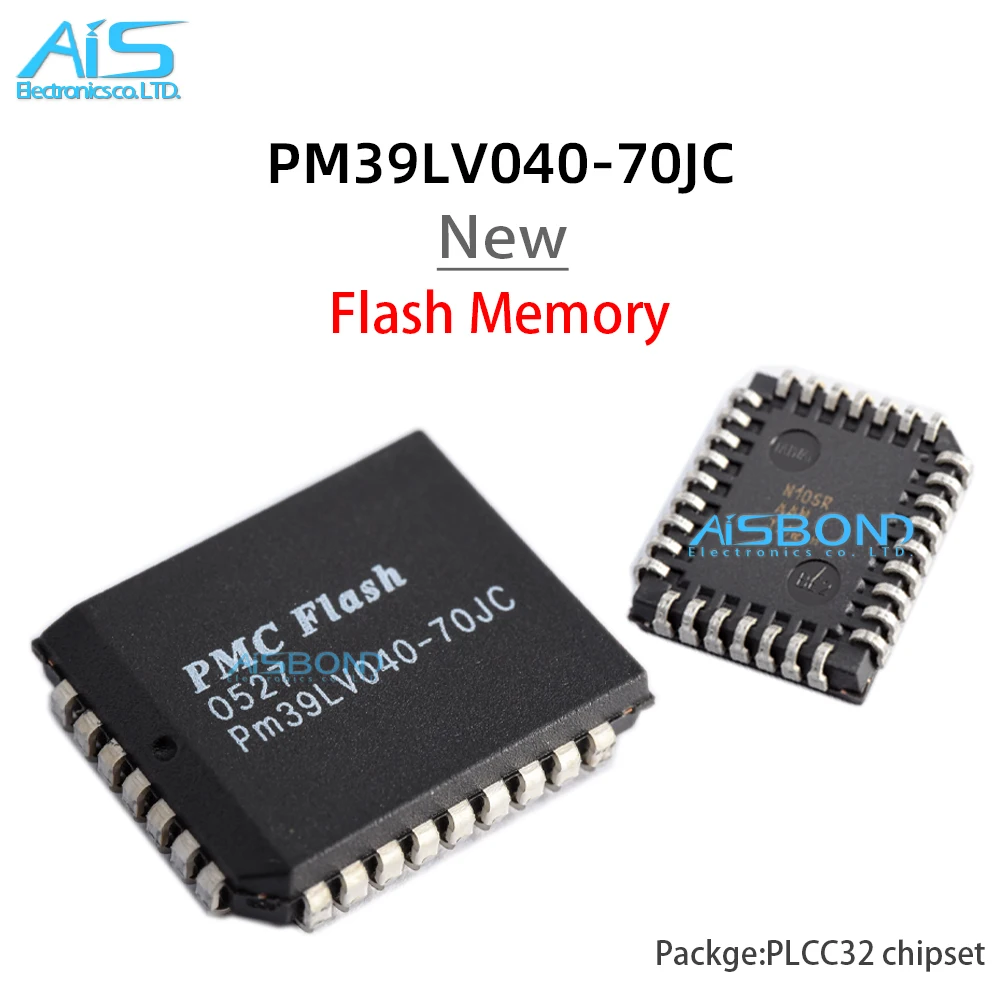First off, why even do this? (2025 Edition)
Before I explain, if you want it quick and to the point...if you came to me asking me "hey xodium, would SATA be a good idea for my Mac? Should I seek out one of these cards?", my advice would be as follows:- Beige PCI Power Mac (not including the G3): Just buy a BlueSCSI v2 if you can live with 10MB/s drive speed and don't need a working optical drive. If you absolutely must, MUST have an optical drive in your system, maybe consider a SATA card?
- G3 Power Macs (including the Blue and White): SATA's probably not a bad idea, the IDE buses on these machines can be...something, especially first rev Blue and Whites. The beige G3s also have half-speed SCSI (5MB/s).
- G4 Power Macs: For the first few revisions? Sure, SATA's great. Digital Audio G4s and newer? It's a mixed bag and if you want utmost reliability here, stick to IDE to SATA bridges. These SATA cards are notoriously picky on Digital Audio/Quicksilver models. MDDs might be okayish. I have heard of people modding the voltage regulation to get these cards working better on these later systems, but that's not a topic I know much about.
But now, we have more options! BlueSCSI v2 exists, and the ZuluSCSI RP2040 on which it is based is no longer close to $100, and both will gladly saturate the 10MB/s SCSI bus in later beige Power Macs (G3 notwithstanding). SATA is still pretty cool, but it's no longer a requirement to get these systems up and running (without spending your life savings). Which is why for most people who just want their systems to work, a SCSI emulator is probably going to be the most foolproof and easy-to-use solution.
And part of that reasoning is that newer Sil3112 clone cards use EEPROMs that require you to have soldering experience, as they use EEPROMs that cannot be flashed in a computer. So if you're coming into this fresh, BE WARNED: You will need to be comfortable with a hot air station AND have a EEPROM programmer that can reprogram PLCC32 flash chips.
(Also for my US-based readers, there's also the problem of tariffs causing these cards to no longer be as cheap as they once were. AliExpress seems to have pulled all the listings if you're searching from the US, and eBay's pricing for these cards can be all over the place.)
If none of that deters you and you want to experience SATA in a place where it clearly shouldn't be, read on:
What works?
- Most SSDs (some newer ones may have trouble, though)
- Hard drives of various sorts! (Though with bigger ones, you will probably want to partition them. I've heard of people having issues with 2TB drives.)
- Optical drives! (At least CDs. I have yet to have a DVD read, but I also haven't pursued this much, yet.)
What doesn't?
- Burning with said optical drive. I haven't tried it yet, but thus far there's no indication that burning software can "see" the burning capabilities of the drive.
- Super high capacity hard drives. If you're going over 2TB, you might have trouble if you don't opt to partition your drives.
Machines that might be problematic
- Digital Audio G4
- Quicksilver G4
Machines known to work
- Power Macintosh 4400
- Power Macintosh 8500
- Power Macintosh 8600
- Power Macintosh 9600 (both Tsunami and Kansas)
- Power Macintosh G3 Beige
- Power Macintosh G3 Blue and White
- Power Macintosh G4 MDD
What can I expect?
It really doesn't matter which route you go here; SATA drives of any sort of a recent vintage are going to saturate the PCI bus all the same, the only thing you can gain on by using an SSD is access/seek times. But given these drives are still going to be leagues faster than anything that would have shipped stock in these machines...you're probably not going to see much improvement. Throw in whatever you wish for, be it SSD or HDD.Optical drives should "just work" much like native IDE/SCSI drives. You can hold the C key to boot from them all the same. The only thing you lose out by going with a SATA optical drive is CD audio support, so if you want to listen to an audio CD with a SATA optical drive you're going to need something like iTunes or Audion (that reads the audio data over the data bus vs. using the CD audio connector.)
As said earlier, these cards "just work" and are picked up as a SCSI bus by the system. These should work in all manner of Macs, from the old world PCI ones, all the way into the New World Macs. These will work as far back as 7.5, and all the way up to 10.4 and maybe even 10.5.
What Sil3112 Card? There's so many!
First, you're going to need an Sil3112-based SATA card. You can find this in a few different ways. Action Retro showed off this strange combo card with an SIL3112 onboard, and that worked fine. You can also just buy one off AliExpress or eBay, they come on generic boards with a cheapo ROM slapped on. These cards will do, but they can be a bit finicky as they're not exactly built to the best standards. The best luck I've had all around is getting a Startech branded Sil3112 card, but those aren't exactly the most common, either.At least until the tariff situation in the US resolves, your best bet is eBay for the generic cards.
Once you have a card in hand, though, you're pretty much golden (unless the vendors who make these cards begin seriously cheaping out and putting 64K EEPROMs on them for some reason). dosdude1 has broken the original ROM wide open (so it'll now work on any EEPROM, not just the ones it was coded to look for) and also compressed it so it'll work on 128K EEPROMs. As of now all of these cards have 128K EEPROMs, so as long as you have a means to program the card (hot air and a programmer) you're good to go; you won't need to purchase any additional parts for this.
If you managed to luck out and get one of these cards that has a lower voltage EEPROM already installed, you're in for a treat: Attached to this post is a SeriTek flasher program that'll work in Mac OS 8/9, and that can just flash the card for you without every needing to touch soldering equipment. Cool, huh? Unfortunately chances of getting a card that can do this off an eBay seller thee days is slim. We never knew how good we had it.
How lucky you are determines the path you're going to take: The first two options will only work if the EEPROM on your card supports low-voltage write/erase operations. If you want to check, you can peel off the SATA RAID sticker and punch the EEPROM model number into Google and see what you get, usually a data sheet that'll tell you. If it says 12 volts for write/erase, sorry to break it to you but you'll need to skip to the hard way.
5 or 3.3 volts should be okay to use the software flashers, but YMMV.
Easy Mode: The Mac OS SeriTek/FirmTek flasher
DEFINITELY TRY THIS FIRST. Unless you like a challenge. Or something. I ain't the boss of you. But if things go well, this is so ridiculously easy I was questioning if it really worked. If you bought your card more recently via the AliExpress link up top, this method probably won't work. Still worth a try though, because it's infinitely easier than the other two methods.Requirements:
- a Mac with a PCI slot
- said Mac being capable of running Classic Mac OS (so, 9.x, I've not tried this on 8.5 or 8.6 yet)
Step 1: Grab the 128K ROM.zip (it's attached to this post, at the bottom)
I'd decompress this on a modern-ish machine just in case Stuffit whines about it on classic Mac OS. I've had mixed luck with .zip files and Stuffit, sadly. Once that's done, though, copy the .ROM file over to the Mac you're going to do the flashing on.Note: I am assuming you're taking a straight-from-aliexpress card and trying to flash it, and most if not all of these have 128K EEPROMs. If you have a 512K EEPROM you can substitute the 3112-512-patched-ROM.zip.
Step 2: Grab the SeriTek1S2Flasher.hqx file (attached to this post, too)
Unlike with the ROM.zip file, you do not need to decompress this on a modern machine. This should decompress just fine in Stuffit Expander. Copy the Flasher.hqx file to your Mac, decompress it and you should have the Flasher application ready to go.Make sure the 1S2-patched-compressed.ROM file and the Flasher application are in the same folder. Start the Flasher app.
Step 3: Read the scary warnings and click a bunch of buttons
Note: Pay close attention to which card you're flashing if you have multiple SATA cards in your Mac. The flasher will allow you to select which one to flash.Anyway, when you start the Flasher, you'll get a scary legalese warning. Click Accept and move on.
Next you'll get a screen telling you what this flasher is going to do. Click Continue.
The next screen will allow you to select which card you want to flash. If you only have the one card installed, it should default to that. If you're using an already-flashed SATA card and are flashing another one, pay close attention. Flashed cards will end in .1S2 for their firmware revision.
Once the right card is selected, click "Update Firmware".
...and now it should erase the EEPROM on the card, and begin flashing it.
Once it's finished, it should pop a message saying as such. If so, restart your Mac, and open Apple System Profiler. Or just connect a HFS-formatted SATA drive to your card, either/or. You should see pretty quickly if it worked. If you're going to ASP, you'll want to look for this under Devices and Volumes:
(It's supposed to come up as a SCSI bus.)
If you see this, your card should be ready to go! Connect your drives and enjoy the ludicrous speed! But if for some reason it didn't work, you'll likely need to take the violent route, which involves programmers, hot air rework, and pain.
Medium Mode: Using flashrom on a PC
Requirements
- a PC that can boot DOS (pretty much anything should be able to)
- said PC having a PCI slot (NOT PCI-E)
- the SATA card itself (it cannot have a blank ROM on it)
I wrote these instructions using a Win98 PC, for the record. You can use whatever you want so long as you can get into DOS and the device the files are stored on can be recognized by DOS.
Repeating this for posterity: the card cannot have a blank ROM on it. If you're opting to swap the EEPROM with a bigger one for whatever reason, you'll want to program the replacement EEPROM first with the instructions under Hurt Me Plenty. Flashrom will just stare at you blank-faced if you try to tell it to flash onto a card with a blank ROM on it.
Step 0: Prepare a DOS boot drive, if needed
I did this by just telling Windows 98 to copy system files to a floppy disk within the formatting dialog. There are many ways to get DOS onto a boot disk, you can do this up to XP, I believe (having the FDD formatter just copy DOS files to the disk). You can also use FreeDOS. I'm going to let you write your own destiny here, as there are so many ways you can go about this.Step 1: Copying the files to the DOS drive
Download the 128K ROM.zip and 3112_Flashing.zip files. Extract them somewhere memorable. You can throw away the 1S2_ROM file in the 3112_Flashing.zip archive, we won't be needing it.Copy flashrom.exe and 1S2-patched-compressed.ROM to either your DOS boot disk or whatever drive you plan on using within DOS. I highly recommend putting them on the root of whatever disk you're using to boot DOS to make the whole process WAY easier.
Step 2: Booting DOS and using flashrom
At this point, reboot your PC into whatever flavor of DOS you chose to use. I can't give specific instructions here because there are so many variables, but I assume you know how to get whatever PC it is you're using to boot from a certain drive.Once you're in DOS you should be sitting at an A: (or C
You can use the dir command to verify everything is in place.
Once everything looks good, you can type this command (flashrom and the ROM file need to be in the same folder/directory)
Code:
flashrom --programmer satasii -w 1S2-patched-compressed.ROMA whole bunch of text should scroll by. You might get some scary-sounding messages like:
Code:
Warning: flash seems unconnected.
This flash part has status UNTESTED for operations:Don't worry, press on. It should be fine. Eventually it'll get down to:
Code:
Reading old flash chip contents... Done.
Erasing and writing flash chip... Erase/write done.What you'll want to see is this at the end, with it dumping you back out to the DOS prompt:
Code:
Verifying flash... VERIFIED.You should now be able to shut down the PC, pull the card, and it should be able to be used in a Mac, now!
Hard Mode: Desoldering the EEPROM and using a programmer
Note: If you're going to go this route, I do recommend looking into getting a lower programming voltage EEPROM so you never have to do this again. That way you can use flashrom/the Mac OS flasher to switch back and forth if you decide you want to stick this card in a retro PC, or something.Requirements:
- Some level of soldering experience
- A hot-air rework station (I used a cheapo one for this)
- A soldering iron (preferably a decent one)
- A programmer (I used a TL866II+ but anything that can write a PLCC32 EEPROM and has compatibility with whatever chip you use SHOULD work)
What programmer do you like?
I personally use Xgecu's stuff, as of this writing I use a T46. I wrote this guide using a TL866II+ and found it to be great, too. But any programmer that can talk to PLCC32 flash chips and reprogram them (at up to 12v) should be fine here.The process
This guide is written using a TL866II+ and XGecu's XGpro software. If you opt to use your own solution, hopefully the directions translate somewhat well to whatever software/programmer you use.First, you're going to want to put the chip in the DIP32 adapter, making sure the dot in the chip is oriented toward the top of the adapter and programmer, like so:
Make sure the handle is locked in the downward position. (Also, I know this is the wrong chip, I'm using it for demonstration purposes.)
Open up Xgpro. It might prompt you to update the firmware on your TL866 if you're using one, follow the directions to do that and come back when you're done. Should be quick.
Go up to the Select menu and pick Search And Select.
A window should pop up:
This is where we tell Xgpro (and the programmer) what chip we're working with. In the upper left, type out whatever chip you have. In this case, you see that I've typed "PM39LV040". Usually it'll autoselect the right one, but sometimes there are multiple form factors. Like in this case there's a TSOP32 version. Make sure you've selected the PLCC32 version and you're good to go.
At this point you can do a quick sanity check and click the READ button and see if the chip will read (even though it's empty). You should see this (pay no mind to the chip ID being different, again, this is a scrap chip I'm using for demo purposes.)
(NOTE: You MIGHT get pin errors on this step. If you do, try and reorient the adapter a little bit. Sometimes it can actually help to pry up on one corner of the EEPROM so it sits in the socket kind of askew. If this was a chip pulled from another card, you might need to check the pins for residual solder.)
If all checks out, now what you want to do is load in the Seritek ROM. Dip into the 3112_Flashing zip attached to this post and you should see a file called 1S2_512.rom. Put it somewhere memorable, this is the file we want.
Back in Xgpro, click the LOAD button:
And point to where you stashed the ROM. The file load window should look like this:
You should not need to mess with any of the options, leave them at their defaults. Click OK. At this point you should start to see some resemblance of data in the main Xgpro window:
Now that we have this loaded into Xgpro, it's time to flash it. Go up to the top of the window and click the PROG button:
A similar window to when we were reading the chip will appear. If all looks good and the chip ID is still correct, go ahead and click "Program". If it was successful, it'll look like this (though hopefully without pin errors like I had here!)
At this point, you're done with the programmer. Hopefully. Get the chip out, it's time to stick it on the card.
Putting the chip on the card
I prefer hot air for this, for both removing and installation. I got out my iron and wet the joints with some fresh leaded solder to lower the melting point, then set my crappy 858D clone to 360c on full speed and got to work, and after about 45 seconds or so the chip came right off the board.After which I took my iron back out, wicked up all the solder, then fluxed and tinned the pads back up.
I put some more flux down, aligned the chip with the tinned pads, and used the hot air once again to install the chip, giving it about a solid minute at the same temp as before. This was enough to make a solid connection for me, but YMMV.
After a quick douse with some electronics cleaner and 91% IPA, I had a clean, flashed SATA card.
Moment of truth...
The only thing left now is to slap the card into a Power Mac and see if anything happens. Thankfully for me it worked first shot; my FAT32-formatted SSD popped up on the desktop of my 9600 immediately. Better yet, Drive Setup just works with this card. I didn't need Patched Drive Setup for any of this. It appears as another SCSI bus to the Mac. Sweet.And because it's a "SCSI" device, that means we can bench it with SCSI Director 4, and my oh MY these numbers.
And that, folks, is how I at least made my 9600 do some ludicrous drive speed.
PSA for AliExpress cards, if you have trouble/weirdness
If you buy one of these and it ends up either not working or working partially (in my case, the card only worked in a New World Mac, not my beige G3 or 9600), check the soldering on the card. Whoever or whatever assembles these cards does NOT do a good job, and in my case, both AliExpress cards I had suffered from cold joints, and in the case of one of them even had a pad completely missing from one of the capacitor locations. Bodged it all up and it works great now, even on the 9600.Wick up the solder and reapply some new stuff with some flux and generally you'll be good to go. I wouldn't be surprised if some of these cards end up shipping with bum capacitors, either. But thus far, haven't heard of any.
Also, unfortunately, these cheapo cards have some...not good voltage regulation. It's enough to pass muster in something like a Power Mac 9600, G3s of varying vintage, and some G4s, but some machines really sensitive to this may not work with these cards. In my case, none of the three cards I have work in my Digital Audio G4. But my Startech-branded one works perfectly fine.
I've heard of people bodging in better voltage regulation to get the cards to work on these more sensitive systems, but I've not looked too deep into that, only known that people HAVE done it.
Attachments
Last edited:




